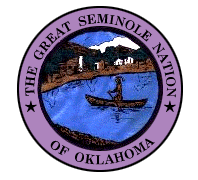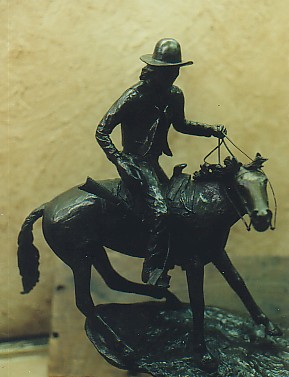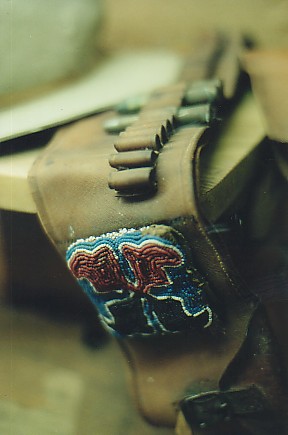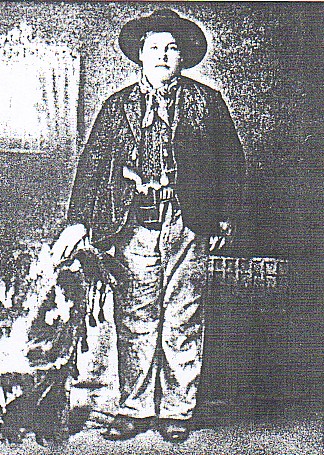

![]()
SEMINOLE LIGHT HORSE POLICE
Organization of the Seminole Light-Horse
|
Seminole Agent Samuel M. Rutherford reported on August 29, 1859, that the Seminoles had no national fund to defray the expenses of government, and as a consequence there was a great laxity in the executions of the laws; that these Indians needed an efficient "Light-Horse" to execute their laws and if those officers were expected to perform their duty, they must be paid. The funds could be withdrawn from the annuity and used for that purpose. Evidently no move was made at that time to establish the Light-Horse. The Civil War was on the horizon before the Seminoles were well established in their new home after their removal from Florida, and all efforts at carrying on any government among them was destined to await the end of the conflict. After the Indians returned to their homes at the close of the Civil War, and times improved, a body of light-horse like those that served so efficiently among the other Civilized tribes, took charge of administering the law in the Seminole Nation. They maintained law and order, and like the celebrated Canadian "Mounties," they always got their man. A. Q. Teague at the age of nineteen, arrived in the Indian Territory from Fort Worth, Texas in 1876, with a drove of cattle for the Seminole Nation. He decided that he would prefer some other work and he was engaged by Governor John F. Brown of the Seminole Nation as a laborer on his farm for the following nineteen years. The youth evidently proved himself efficient as Governor Brown asked him how he would like to become a light-horseman. "I told him that I couldn't be a light-horseman, but he said, "Yes you can. You just do what I tell you to do." "I said, Yes, but you might tell me to kill a man and I couldn't do that." "He said, Yes, you just kill him if I tell you to." " A light-horseman was just the same as a policeman, so I was made a Light-horseman." A. P. Shaw was born November 5, 1860, at Bates, Missouri, arrived at Wewoka in September, 1894. He was employed on trial by Governor Brown for one month and as he gave satisfaction he was given charge of all of the saws and other machinery in the Governor's mills at Wewoka and Sasakwa. Mr. Shaw related that the Seminole Light-Horse numbered about twelve at that time and the captain was Jim Larney. Court was held in the old Council House at Wewoka, and "prisoners were punished by the lash law, their feet being tied together with a long pole. The prisoner's hands were tied together with a long rope thrown over a high limb of a tree and two light-horsemen would then pull the prisoner until his body was stretched to full length and then he would be given his lashes on a bare back. After he was whipped, he would put on his shirt with back bleeding with nothing done for his wounds. Joe M. Grayson, Henryetta, Oklahoma was of the opinion that Governor Brown was a very smart Indian. Like all merchants in the Territory he sold his goods on credit, trusting to make his collections when Indian were paid their "head-rights." The money for the Seminoles was hauled in wagons and they were paid every three months. Two light-horsemen rode in the wagon, one rode in front, two on each side, and two behind. All were heavily armed and no one ever had the courage to attack them so they always arrived at their destination without trouble. Among other Seminole light-horsemen were Pomp Davis and Caeser Payne who frequently accompanied members of their tribe to Wewoka for trial. Chepon Moses of Wewoka related that when he was a youth he made his home with an uncle of the name of Harrison who was a light-horseman. During a drunken fight between Pul-musky and John Factor the last named was killed, and Pul-musky was sentenced to death. He was freed until the day appointed for his execution and "when the time, day, and hour, came the prisoner was here among the crowd and he walked forward. He was blind-folded, and he sat on a rock by a tree: a white paper heart was cut and placed over his heart and then two light-horsemen were selected to shoot him. Cumsey (Tecumseh?) Bruner and Caeser Payne were the ones and they were negros. Another description of punishment by the light-horsemen was given by John Alexander Frazier of Elk City, Oklahoma. He stated that when he arrived in Wewoka the Seminoles had their own laws and executed their criminals. "They brought out an Indian and took off his shirt, then they tied his hands and feet together with ropes. Then these Indians took a long lariat rope and tied him to a rail and took him to a log cabin, the roof of which had almost rotted off, and threw the rope over one end of a log that was sticking out...Two men got on the rail and five or six men got hold of the rope and stretched the criminal up in the air. Then the Indian Chief ordered the light-horse-men all to fall in line and walk up to the criminal. Each light-horseman had a hickory stick three of four feet long in his hand. There were ten light-horsemen in line and the Indian Chief gave orders that they should step up one at a time and each should give the culprit ten licks. If the light-horsemen dropped his whip he had to fall out of line...
|
![]()
|
Light Horsemen-Seminole Nation - Wewoka, I. T. 1904 |
Seminole Chief John Chupco (seated
center) |
![]()

Seminole Laws
Chapter 6
Chapter six of the Seminole Laws, as furnished by the U.S. Indian inspector for Indian Territory, and translated by G.W. Grayson, July 1906, contains the following fifteen sections:
Sec. I The Seminole Nation shall have a force of Light Horsemen.
II. The Company of Light Horse shall consist of one Captain, one Lieutenant, and eight privates, in all, ten men.
III. The Company of Light Horse when installed in office shall serve for the term of four years.
IV. If by reason of death, or the violation of any law of the Nation by any member of the Company, his place on the force becomes vacant. It shall be the duty of the National Council to fill such vacancy or make any other arrangement that shall be satisfactory.
V. If any member of the Light-Horse company shall resign his office, the chiefs shall report such resignation to the National Council, when it will become the duty of that body to fill the vacancy.

VI. The Light Horse company when in charge of a prisoner under arrest, shall exercise due humanity and care in the treatment accorded him during his imprisonment.
VII. If a Light Horsemen shall, through neglect of duty, or flagrant carelessness, suffer a prisoner in his charge to escape from his custody, he shall be deemed guilty.
VIII. If it shall be proved that any Light Horseman by drinking whisky or any other intoxicant, had become intoxicated, he shall be deemed guilty.
IX. Power and authority are hereby vested in the chiefs of the Nation to issue warrant for arrest; and the Light Horsemen shall make no arrests without first having received such warrant from the chiefs.
X. The chiefs shall first be fully satisfied that an act of violence of law has been committed before issuing a warrant for arrest.
XI. In making arrests, the Light Horsemen shall exercise due care that no unnecessary physical pain or other injury is inflicted on the person being arrested.

XII. If the Light Horseman shall proceed to effect the arrest of any person, abiding by and observing the requirements of the foregoing section of his official acts; and if, notwithstanding the orderly deportment of the officer, the person to be arrested shall make resistance by force of arms, then the arresting officer shall have the right to kill him.
XIII. Such a killing shall be deemed to be the legitimate result of the operation of law.
XIV. The Chiefs are hereby authorized to engage a posse to aid the Light-Horse when necessary, who shall be subject to the laws governing the Light-Horsemen.
XV. The posse so engaged shall be paid the per diem of one ($1.00) dollar by the Nation
Passed by the National Council January 28th, 1903 OKFUSKEY MILLER, Chairman T. S. McGiesey, Clerk
Approved January 28, 1903
HULBUTTA MIKKO, Principal Chief Seminole Nation
THOMAS LITTLE, 2nd Chief, S.N.
-Courtesy of Carolyn Thomas Foreman
![]()

Captain Chili Fish
Last Captain of the Light Horsemen
![]()
|
Names from the past associated with the Seminole Light-horse police include Captain Lonnie, Captain Jacob Harrison, Captain Thomas Cloud and Captain Chili Fish who later refused the office of Chief of the Seminole Nation after Oklahoma statehood. Chilli Fish was the last captain of the Seminole Light-horse police during that era. Other members of the Light-horse included black members of the tribe known as Freedman such as Cumsey Bruner, John Dennis, Tom Payne, Ceasar Payne, Thomas Bruner and Sam Cudgo. The most famous Seminole Freedman Light-horseman was Dennis Cyrus, who served with the Light-horse for twenty-five years. Five of those years, Cyrus held a deputy U.S. Marshall commission from the U.S. Marshal John Carroll at Fort Smith, Arkansas. Dennis Cyrus was involved in a shooting altercation in Muskogee in August of 1905. Cyrus was a delegate at a political convention in town. While resting at a rooming house , a fight occurred in the room next door. O. J. Mitchell, a prominent businessman in Muskogee was having a fight with a lady friend. During the dispute, Mitchell barged in to Cyrus' room with a gun in hand. Cyrus told him to drop the weapon. Mitchell hesitated and Cyrus shot him in the right shoulder, Mitchell later recovered from his wound and Cyrus was exonerated of the shooting. At the time of the incident the Muskogee Times Democrat reported that Dennis Cyrus was a posse man for deputy U.S. marshal John Cordell, stationed at Wewoka. The Muskogee Cimeter stated: "Dennis Cyrus is one of the best officers in the Western District and is always faithful in the performance of duty. Those who know him best know that he is a brave and fearless officer and that he would not injure anyone without permission." During the territorial era of the Indian Territory, the Seminole Nation council served as the court and the chief was the acting judge when criminal cases were adjudicated. The laws in the nation were enforced by the police known as the Light-horse. The Light-horse were the pick of the tribe, the cream of the crop, selected by the council for fearlessness and honesty. Their job was to track down criminals and bring them to the council house in Wewoka. If the need arose the chief could hire "special" Light-Horsemen. In May of 1885, a heavily armed band of white cowboys who worked the Pottawatomie Reservation openly stole sixty head of cattle the belonged to the Seminole Indians. Principal chief John Jumper raised a force of fifty "special" Light-Horse to guard the western border of the nation. John F. Brown, the sub-chief, secured from the Federal authorities an assurance that any whites caught stealing form the Seminoles, and resisting arrest by Seminole Light-horse, could be killed without prosecution for murder by the federal court in Fort Smith. On many occasions the Seminole Light-horse would hold non-citizens for the deputy U.S. marshals to take back to the federal jail in Fort Smith, Arkansas. Deputy U.S. marshal Bass Reeves picked up many fugitives in this fashion at Wewoka.
Killed In The Line Of Duty Four Seminole Light-horsemen are known to have been killed in the line of duty before Oklahoma statehood. Light-Horseman Dickie Lane Around 1899, a condemned man failed to show up for his execution. Light-horseman Dickie Lane was sent into the Sasakwa-Konawa area to bring him to Wewoka. Lane was shot attempting to arrest the felon, Lane, though badly hurt, was successful in getting in his wagon and starting back to Wewoka. Lane bled to death before he could reach help. He was found and brought back to the Seminole capitol. Burial took place at Lucenda Coker's place, but the grave has since been plowed over. Lane was described by his grand-daughter, Maria Hall, as an individual who was slow to anger and one who stood by a person in need. Light-Horse Captain Thomas Cloud Light-Horseman Sam Cudgo Captain Thomas Cloud and seventeen Light-horsemen, on March 29, 1885, were searching for outlaws in a black settlement on the south side of the Canadian River near Sacred Heart Mission. At the residence of Paro Bruner they found Rector Rogers, who had killed his brother the previous fall in the Creek Nation. Rogers told the posse he was not going to talk to them and slammed the door. Rogers began shooting at the posse from the cabin. Light-horseman Sam Cudgo was hit in the abdomen with a shot from Roger's rifle. Cudgo died about an hour after being wounded. The posse poured a furious volley of gunfire into the cabin. One of the gunshots from Rogers hit Captain Cloud in the thigh of the left leg, where the bullet shattered the bone. Captain Cloud told his men to not let Rogers escape at any cost. Cudgo's body was taken to Wewoka, and the seriously wounded Captain Cloud was taken to the home of Seminole chief John Jumper in Sasakwa. Cloud died there. Cloud had also served as a member of the United States Indian Police and had been a United States mail contractor. Light-Horseman Billy Cully On February 3, 1906, Light-horseman Billy Cully was murdered in a shack five miles west of Sasakwa. Three men were implicated in the murder: Alex Harjo, Barney Fixico, and Wild Cat. Cully had been killed by a blow to the head with a blunt instrument. During the previous Christmas, Cully had an altercation with Alex Harjo, so there was bad blood between them. Deputy U.S. marshal Bass Reeves immediately recognized Wild Cat as a prisoner who had escaped his custody twenty years earlier. The lawman had presumed Wild Cat was dead. Billy Cully was described as well educated. He was the brother-in-law of Governor Brown. Although the smallest police force of the Five Civilized Tribes in the Indian Territory, the Seminole Light-horse police were the most feared by lawbreakers in the "Nations." Their record and dedication to duty is an example of outstanding law enforcement on the Oklahoma Frontier~ Interestingly, the term "light-horse" came from Revolutionary War hero General Henry Lee due to his capability of cavalry movements during the conflict, earning him the nickname "Light-horse Harry." General Henry Lee was the father of General Robert E. Lee. Above Text courtesy of Art T. Burton, Historian
Light-Horseman-Peter Osana, Kinda Palmer, Tulmarsey (James Wise), & Tom Coker (Creek) serving as Seminole Light-Horseman are mentioned in the book Seminole Burning, A Case of Racial Vengeance. It is the only documentation I've found on these Light-Horsemen, thus far. Sculpture of the Light-Horseman by Bob Bell. Light-Horse saddle owned by Dave Coker. Beaded gun belt and hat courtesy of the Seminole Nation Museum. These photographs are copyrighted by Seminole Nation, I. T. and may not be duplicated with out permission.
1.
Unknown Indian Police 2. Unknown Indian Scouts 3. Members of the Choctaw
Light-Horse Last of the Seminole Light - Horse
©2001 -
Present
02 August 2015 |